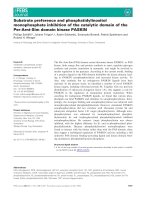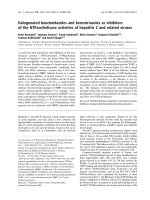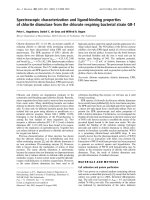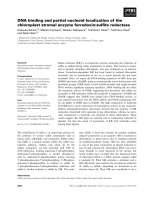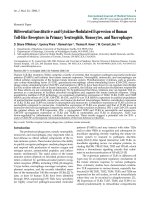Báo cáo y học: " Mucocele-like tumor and columnar cell hyperplasia of the breast occurring in a morphologic continuum" pptx
Bạn đang xem bản rút gọn của tài liệu. Xem và tải ngay bản đầy đủ của tài liệu tại đây (473.01 KB, 4 trang )
BioMed Central
Page 1 of 4
(page number not for citation purposes)
Journal of Medical Case Reports
Open Access
Case report
Mucocele-like tumor and columnar cell hyperplasia of the breast
occurring in a morphologic continuum
Oluwole Fadare*
1,2
and M Rajan Mariappan
3,4
Address:
1
Department of Pathology, Wilford Hall Medical Center, Lackland AFB, TX 78236, USA,
2
Department of Pathology, University of Texas
Health Science Center at San Antonio, San Antonio, TX 78229, USA,
3
Department of Pathology, Beth Israel Deaconess Medical Center, Boston,
MA, USA and
4
Department of Pathology, Harvard Medical School, Boston, MA, USA
Email: Oluwole Fadare* - ; M Rajan Mariappan -
* Corresponding author
Abstract
Introduction: Mucocele-like tumor was originally described in 1986 as a benign breast
proliferation consisting of multiple dilated cysts lined by cytologically bland, flat to cuboidal cells.
Subsequent reports described the coexistence of, including the morphologic inter-transitions
between, mucocele-like tumor and a variety of other breast proliferations, including intraductal
carcinoma, invasive carcinoma, atypical ductal hyperplasia, and hyperplasia of the usual type. The
spectrum of breast alterations characterized by variably enlarged terminal-ductal lobular units lined
by variably hyperplastic and variably atypical columnar cells has been the subject of significant
discussion in the recent literature. In one scheme, these lesions may be classified into four groups,
that is, columnar cell change with and without atypia and columnar cell hyperplasia with and
without atypia. Morphologic and molecular observations suggest an association, perhaps in a
nonobligate precursor role, between some columnar cell lesions and a variety of other neoplastic
lesions.
Case presentation: We describe the case of a 43-year-old woman whose breast tumor
contained areas diagnostic of mucocele-like tumor and columnar cell hyperplasia, with morphologic
transitions in between.
Conclusion: Our case represents the second broadly similar case that has been reported, and
suggests a potential relationship between these two enigmatic lesions.
Introduction
Mucocele-like tumor (MLT) was originally described in
1986 as a benign breast proliferation consisting of multi-
ple dilated cysts lined by cytologically bland, flat to cuboi-
dal cells [1]. Subsequent reports described the coexistence
of, including the morphologic inter-transitions between,
mucocele-like tumor and a variety of other breast prolifer-
ations, including intraductal carcinoma, invasive carci-
noma, atypical ductal hyperplasia, and hyperplasia of the
usual type. The spectrum of breast alterations character-
ized by variably enlarged terminal-ductal lobular units
lined by variably hyperplastic and variably atypical
columnar cells has been the subject of significant discus-
sion in the recent literature. In one scheme, these lesions
may be classified into four groups, that is, columnar cell
change with and without atypia and columnar cell hyper-
plasia with and without atypia. Morphologic and molecu-
lar observations suggest an association, perhaps in a
Published: 30 April 2008
Journal of Medical Case Reports 2008, 2:138 doi:10.1186/1752-1947-2-138
Received: 25 December 2007
Accepted: 30 April 2008
This article is available from: />© 2008 Fadare and Mariappan; licensee BioMed Central Ltd.
This is an Open Access article distributed under the terms of the Creative Commons Attribution License ( />),
which permits unrestricted use, distribution, and reproduction in any medium, provided the original work is properly cited.
Journal of Medical Case Reports 2008, 2:138 />Page 2 of 4
(page number not for citation purposes)
nonobligate precursor role, between some columnar cell
lesions and a variety of other neoplastic lesions. We
describe herein a case that suggests a possible link
between MLT and columnar cell lesions.
Case presentation
During a routine mammogram, a 43-year-old African-
American woman with no prior history of breast disease
was noted to have several clusters of pleomorphic left
breast calcifications. A biopsy of the associated mass
lesion was subsequently performed and showed large
areas of mucin extravasation and fibrosis but no areas that
were unequivocally diagnostic of neoplasia. Mucinous
carcinoma could not be excluded based on the pathologic
findings, so a decision was made to excise the mass. A nee-
dle-localized excision was performed approximately 1
month after the biopsy.
The excised sample, which measured 10.4 cm, was proc-
essed in its entirety for microscopic evaluation. Sections
showed diffuse changes diagnostic of MLT, including
large cystic spaces lined predominantly by flat attenuated
epithelium and variably filled with a lightly amphophilic
material (Fig. 1). Occasionally, the lining showed hyper-
plastic changes. Admixed with the large cystic spaces were
tubules with changes diagnostic of nonatypical columnar
cell hyperplasia. The latter areas were lined columnar
cells, approximately three-cells thick, with variable lumi-
nal snouts and no significant cytologic atypia. Notably,
some cysts featured an apparent morphologic continuum
between the columnar cell areas and the more conven-
tional MLT areas with flat epithelial lining (Figure 2).
Transitions were generally 'gradual' within a given duct. In
other areas, the lining of the cysts was low cuboidal, that
is, within the morphologic spectrum of MLT but sugges-
tive of a transition to columnar cell lesions. A few colum-
nar cell lesions displayed cytologic atypia (Figure 3), but
none of the latter showed morphologic transitions with
the MLT areas. All areas of the lesion displayed myo-epi-
thelial cells.
Immunohistochemically, the columnar and flat areas had
similar Ki-67 proliferative indices, which ranged from 1%
to 5% (average 1.7% for MLT, 1.2% for columnar cell
lesions without atypia and 3.4% for columnar cell lesions
with atypia; mouse monoclonal antibody against human
ki-67 antigen, clone mib-1, isotype IgG1-kappa, dilution
1:100, DakoCytomation, Carpinteria, California), and
both displayed diffuse immunoreactivity for the estrogen
receptor (ER-alpha, mouse monoclonal antibody, clone
ID5, dilution 1:50, DakoCytomation). To a large extent,
neither the columnar cells nor the attenuated cells of the
MLT showed a reduced intensity and/or extent of staining
for high molecular weight keratins (HMWK) (mono-
clonal antibody, clone 34betaE12, dilution 1:50, DakoCy-
tomation), compared with the background ductules.
However, in scattered columnar cell-lined ductules, which
constituted less than 5% of the columnar cell lesions,
which were unassociated with the MLT, and which corre-
sponded to the foci of flat epithelial atypia, the columnar
cells showed reduced staining for HMWK. Identical results
were found when anti-HMWK was replaced with antibod-
ies to cytokeratin 5/6 (mouse monoclonal antibody,
clone D5/16 B4, prediluted, LabVision Corporation/Neo-
markers Inc, Fremont, California).
Within this single dilated duct is a portion lined by hyperplas-tic columnar cells (single arrow) and flat epithelial cells of the mucocele-like tumor (double arrow)Figure 2
Within this single dilated duct is a portion lined by
hyperplastic columnar cells (single arrow) and flat
epithelial cells of the mucocele-like tumor (double
arrow). Hematoxylin and eosin stain, magnification ×200.
Mucocele-like tumorFigure 1
Mucocele-like tumor. Hematoxylin and eosin stain, magni-
fication ×80.
Journal of Medical Case Reports 2008, 2:138 />Page 3 of 4
(page number not for citation purposes)
Discussion
MLT of the breast was originally described by Rosen [1] as
a benign proliferation consisting of multiple dilated cysts
lined by cytologically bland, flat to cuboidal cells. Subse-
quent reports described the coexistence of, including the
morphologic inter-transitions between, MLT and a variety
of breast proliferations, including intraductal carcinoma,
invasive carcinoma, atypical ductal hyperplasia and
hyperplasia of the usual type [2-4]. Most invasive carcino-
mas that arise in this setting are of the mucinous type [4],
and some authors have postulated a morphologic and
biologic continuum between MLT and mucinous carcino-
mas [3].
The spectrum of breast alterations characterized by varia-
bly enlarged terminal-ductal lobular units lined by varia-
bly hyperplastic and variably atypical columnar cells has
been the subject of significant discussion in the recent lit-
erature. In the nosological scheme of Schnitt and Vincent-
Salomon [5], these lesions may be classified into four
groups, that is, columnar cell change with and without
atypia and columnar cell hyperplasia with and without
atypia. Lesions with cytological atypia correspond closely
with the lesions described as 'flat epithelial atypia', which
are recognized in the World Health Organization classifi-
cation [6,7]. Morphologic and molecular observations
suggest an association, perhaps in a nonobligate precursor
role, between flat epithelial atypia and lobular neoplasia,
tubular carcinoma and low-grade intraductal carcinoma
[5-7]. Retrospective analyses have suggested that they may
represent a marker of a slightly increased risk for the sub-
sequent development of invasive carcinoma when they
are identified in a biopsy [7].
One analysis of columnar cell lesions by comparative
genomic hybridization found loss of heterozygosity
(LOH) involving 16q, 15q, 16p and 19 in 10 out of 14
cases [8]. This study also showed additional chromo-
somal abnormalities in columnar cell hyperplasia. How-
ever, more recent LOH studies failed to demonstrate any
loss of heterozygosity in columnar cell changes without
atypia in the three cases analyzed, and LOH in two out of
three cases with columnar cell hyperplasia [9]. Hence, the
significance, if any, of columnar alterations without sig-
nificant cytologic atypia remains uncertain.
We have described here a breast lesion which appeared to
suggest a potential relationship between MLT and colum-
nar cell hyperplasia given their coexistence and the mor-
phologic transitions between these two lesions. The
proliferative indices of the columnar cell lesions and the
MLT were heterogeneous but remarkably low, although
areas with flat epithelial atypia displayed slightly higher
proliferative activity. The low proliferative activity in
columnar cell lesions noted in this case is compatible with
data reported in a recent study [10]. Both MLT and colum-
nar cell hyperplasia without atypia may simply represent
lesions that share derangements in the unfolding of the
terminal-ductular lobular units.
This case is somewhat similar to a case recently reported
by Coyne [11]. However, in that case, all the cystically
dilated spaces were lined by columnar cells, suggesting
that the columnar cell lesions were simulating an MLT, as
indicated by the author's caption "Columnar cell hyper-
plasia with intraluminal crystalloids and features of a
mucocoele-like lesion" [11]. The case we have described
here, in contrast, showed morphologic transitions
between areas that are individually diagnostic of MLT and
columnar cell hyperplasia without atypia. Nevertheless,
these reports suggest that future investigations into a pos-
sible link between these two lesions are warranted.
Conclusion
A single breast tumor that showed a morphologic contin-
uum between mucocele-like tumor and columnar cell
hyperplasia is described, which is suggestive of a possible
link between these two lesions.
Abbreviations
HMWK: high molecular weight keratins; LOH: loss of het-
erozygosity; MLT: mucocele-like tumor.
Competing interests
The authors declare that they have no competing interests.
Columnar cell lesions with atypia (flat epithelial atypia)Figure 3
Columnar cell lesions with atypia (flat epithelial aty-
pia). Hematoxylin and eosin stain, magnification ×200.
Publish with BioMed Central and every
scientist can read your work free of charge
"BioMed Central will be the most significant development for
disseminating the results of biomedical research in our lifetime."
Sir Paul Nurse, Cancer Research UK
Your research papers will be:
available free of charge to the entire biomedical community
peer reviewed and published immediately upon acceptance
cited in PubMed and archived on PubMed Central
yours — you keep the copyright
Submit your manuscript here:
/>BioMedcentral
Journal of Medical Case Reports 2008, 2:138 />Page 4 of 4
(page number not for citation purposes)
Authors' contributions
OF performed the pathologic evaluation of the case. OF
and MRM co-wrote the manuscript. Both authors read and
approved the final version of the manuscript.
Consent
Written informed consent was obtained from the patient
for publication of this case report and any accompanying
images. A copy of the written consent is available for
review by the Editor-in-Chief of this journal.
Acknowledgements
The views expressed in this article are those of the authors and do not
reflect the official policy of the Department of Defense or other Depart-
ments of the United States Government.
References
1. Rosen PP: Mucocele-like tumors of the breast. Am J Surg Pathol
1986, 10(7):464-469.
2. Ro JY, Sneige N, Sahin AA, Silva EG, del Junco GW, Ayala AG:
Mucocelelike tumor of the breast associated with atypical
ductal hyperplasia or mucinous carcinoma. A clinicopatho-
logic study of seven cases. Arch Pathol Lab Med 1991,
115:137-140.
3. Weaver MG, Abdul-Karim FW, al-Kaisi N: Mucinous lesions of the
breast. A pathological continuum. Pathol Res Pract 1993,
189(8):873-876.
4. Hamele-Bena D, Cranor ML, Rosen PP: Mammary mucocele-like
lesions. Benign and malignant. Am J Surg Pathol 1996,
20(9):1081-1085.
5. Schnitt SJ, Vincent-Salomon A: Columnar cell lesions of the
breast. Adv Anat Pathol 2003, 10(3):113-124.
6. Leibl S, Regitnig P, Moinfar F: Flat epithelial atypia (DIN 1a, atyp-
ical columnar change): an underdiagnosed entity very fre-
quently coexisting with lobular neoplasia. Histopathology 2007,
50(7):859-865.
7. Martel M, Barron-Rodriguez P, Tolgay Ocal I, Dotto J, Tavassoli FA:
Flat DIN 1 (flat epithelial atypia) on core needle biopsy: 63
cases identified retrospectively among 1,751 core biopsies
performed over an 8-year period (1992–1999). Virchows Arch
2007, 451(5):883-891.
8. Simpson PT, Gale T, Reis-Filho JS, Jones C, Parry S, Sloane JP, Hanby
A, Pinder SE, Lee AH, Humphreys S, Ellis IO, Lakhani SR: Columnar
cell lesions of the breast: the missing link in breast cancer
progression? A morphological and molecular analysis. Am J
Surg Pathol 2005, 29(6):734-746.
9. Dabbs DJ, Carter G, Fudge M, Peng Y, Swalsky P, Finkelstein S:
Molecular alterations in columnar cell lesions of the breast.
Mod Pathol 2006, 19(3):344-349.
10. Noel JC, Fayt I, Fernandez-Aguilar S, Buxant F, Boutemy R: Prolifer-
ating activity in columnar cell lesions of the breast. Virchows
Arch 2006, 449(6):617-621.
11. Coyne JD: Columnar cell hyperplasia with intraluminal crys-
talloids and features of a mucocoele-like lesion. Histopathology
2004, 44(4):401-403.



